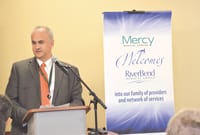How to Fight America’s Obesity Epidemic
Although President Barack Obama looks trim and fit, the same cannot be said for most Americans, as two-thirds of adults and one-third of children in the U.S. are overweight or obese — a trend that has persisted for the last decade and shows no signs of abatement.
If the trend continues, obesity will account for more than $860 billion, or more than 16{06cf2b9696b159f874511d23dbc893eb1ac83014175ed30550cfff22781411e5}, of health care expenditures in the United States by 2030, according to a study in the Journal of the American Medical Association.
Unless there is a strategy to reverse this epidemic, today’s generation of children and adolescents may experience disability and death at earlier ages than their parents, reversing a pattern of general improvement in health, productivity, and quality of life.
Earlier this year, the Public Health Advocacy Institute, a nonprofit legal research center that focuses on public health law, located at Northeastern University’s School of Law, brought together legal scholars, public officials, public health experts, and others to develop recommendations for the new president.
The group developed a number of recommendations for the new administration that cover such areas as the economic and social aspects of dietary behavior, ensuring equal access to healthy food and physical activities, food marketing regulations, integrating policy approaches to childhood and adult obesity, and menu-labeling laws.
Among the 47 recommendations:
- Impose federal taxes on purchases of unhealthy foods and beverages, and earmark the revenue for obesity education and prevention programs.
- Promote and fund innovative farm-to-schools and farm-to-community programs to support local farmers and increase access to locally grown food.
- Establish and implement financial incentives for schools to improve and promote enhanced nutrition standards in the National School Lunch and Breakfast Programs and the Child and Adult Care Food Program.
- Expand the reach of federal food programs by automatically enrolling low-income individuals and families found eligible for other public-assistance programs.
- Amend the federal No Child Left Behind Act in the 2009 reauthorization to require physical education as a core subject.
- Increase funding for the federal Child Nutrition Bill to support increases in the amount and quality of fruits and vegetables provided in schools, school staff nutrition training, school-based fruit and vegetable snack programs, and student food and nutrition education.
- Establish strict federal regulations limiting food and beverage advertising to children.
- Provide federal support for technical assistance and education to restaurateurs and the general public to implement and evaluate state and local menu-labeling laws.
- Increase federal National Institutes of Health funding for nutrition research.
These recommendations are reasonable, achievable, and would have a significant impact on this mounting public health crisis. They should be high on the new administration’s list of priorities.
The absence of an aggressive and effective federal obesity policy would bring untenable public health and economic consequences.-
Richard A. Daynard is a professor at Northeastern University’s School of Law and president of the Public Health Advocacy Institute. Mark Gottlieb is executive director of the institute.


